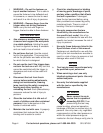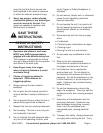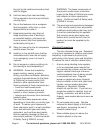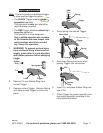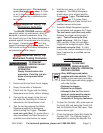
Page 9For technical questions, please call 1-800-444-3353.SKU 67450
Air Supply
TO PREVENT
EXPLOSION:
Use only clean, dry, regulated,
compressed air to power this
tool. Do not use oxygen, carbon
dioxide, combustible gases, or
any other bottled gas as a power
source for this tool.
Quick
Coupler
Recommended Air Line Components
Regulator with
Pressure Gauge
Quick
Coupler
Air Hose
on Reel
Valve FilterOiler
Coupler
Plug
Tool
Air
Compressor
Coupler
Plug
1.
pressure gauge, oiler, in-line shutoff ball
valve, and quick coupler for best service,
as shown in the diagram above. An in-
line shutoff ball valve is an important
safety device because it controls
the air supply even if the air hose is
ruptured. The shutoff valve should be
a ball valve because it can be closed
quickly.
Note: If an automatic oiler system is not
used, add a few drops of Pneumatic Tool
Oil into the tool at the airline connection
before operation. Add a few more drops
after each hour of continual use.
Attach an air hose to the compressor’s 2.
air outlet. Connect the air hose to the air
inlet of the tool. Other components, such
as a coupler plug and quick coupler, will
not required. Attachment of a coiled air
hose (sold separately) will add versatility
to this tool.
WARNING! TO PREVENT SERIOUS
INJURY FROM ACCIDENTAL
OPERATION:
Do not install a female quick coupler
on the tool. Such a coupler contains
an air valve that will allow the air tool to
retain pressure and operate accidentally
after the air supply is disconnected.
Note:
performance, can be hindered by
undersized air supply components.
The air hose must be long enough to 3.
reach the work area with enough extra
length to allow free movement while
working.
Release the tool’s trigger.4.
Close the in-line safety valve between 5.
the compressor and the tool.






